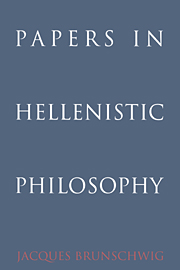Book contents
- Frontmatter
- Contents
- Acknowledgements
- Preface
- I EPICUREANISM
- II STOICISM
- 3 Remarks on the Stoic Theory of the proper noun
- 4 Remarks on the classification of simple propositions in Hellenistic logics
- 5 The conjunctive model
- 6 The Stoic theory of the supreme genus and Platonic ontology
- 7 On a Stoic way of not being
- 8 Did Diogenes of Babylon invent the Ontological Arugument?
- III SCEPTICISM
- Bibliography
- Index of subjects
- Index of names
- Index of passages cited
4 - Remarks on the classification of simple propositions in Hellenistic logics
Published online by Cambridge University Press: 25 October 2009
- Frontmatter
- Contents
- Acknowledgements
- Preface
- I EPICUREANISM
- II STOICISM
- 3 Remarks on the Stoic Theory of the proper noun
- 4 Remarks on the classification of simple propositions in Hellenistic logics
- 5 The conjunctive model
- 6 The Stoic theory of the supreme genus and Platonic ontology
- 7 On a Stoic way of not being
- 8 Did Diogenes of Babylon invent the Ontological Arugument?
- III SCEPTICISM
- Bibliography
- Index of subjects
- Index of names
- Index of passages cited
Summary
‘The first and chief difference among propositions (ἀξιώματα), the dialecticians say, is that between simple (ἁπλᾶ) and non-simple (οχὐ ἁπλᾶ)'. These are the words of Sextus Empiricus (M VIII.93) and nobody would challenge the importance of that distinction. The declaration introduces a long passage (93 – 129) which sets out the subdivisions within this fundamental division. It is a passage which historians of logic tend to use as one of the sources that provide us with information on the Stoic classification of propositions, despite the fact that the Stoics are not specifically named, for it is generally accepted that Sextus does refer to them as ‘the dialecticians’. The task that faces us, then, is to compare his text with the classification transmitted to us by Diogenes Laertius (VII.68–76), who possibly bases his remarks on Diocles of Magnesia, – a classification which, for its part, is explicitly ascribed to Chrysippus and a number of his successors.
These texts, which have often been studied, present a number of similarities and also a number of differences. They pose many problems involving an inextricable mixture of historical questions, conceptual complications and textual difficulties (Diogenes' text is not in a good state).
- Type
- Chapter
- Information
- Papers in Hellenistic Philosophy , pp. 57 - 71Publisher: Cambridge University PressPrint publication year: 1994
- 3
- Cited by



